I know some of you get tired of updates about little things, but we at Hangar Thirteen LOVE the little details. Some of you might remember how, back in 2019, we went through so much trouble to locate the correct toilet paper holder for the Boeing B-17.
Well, here we have another seemingly innocuous find that is, in reality, a very big deal for us – we found the paper cup dispenser!
Believe it or not, it took us SIX YEARS to find this piece.
Up until very late in the F-series (F-115-BO to be exact), the cockpit of the B-17 came standard with a pair of Stanley aircraft thermoses. Manufactured by Landers, Frary & Clark of New Britain, Connecticut (a major name in early- housewares), the thermoses were mounted above the hydraulics panel on the right wall. Some of you might recall the trouble we went through to find original USAAF issue thermoses, finally completing a matching pair in 2021. The cup dispenser proved to be a far greater challenge.
The cup dispenser was located on the back of the co-pilot’s seat and was referred to in the blueprints as no. 39D3339. This was less than helpful. Original examples are few and far between, though there are a couple survivors currently aboard Boeing B-29s, as they used the same type. However, since we recently acquired a flight thermos for the Consolidated LB.30/B-24 Maid of Athens, we started researching the cup dispenser for it as well. This cup dispenser was different, being long and cylindrical in shape, however Consolidated was kind enough to share the civilian make of their unit: Lily-Tulip No. 452. We have yet to find this particular cup dispenser, but while looking, we stumbled upon the B-17’s unit – apparently it too was made by Lily-Tulip!
I know it seems silly to be so excited about a paper cup dispenser, but this is truly a happy find for us!
Now all that remains is to fabricate the rack and tension clips for the B-17’s thermoses. If any of you have experience in metal fabrication and would be interested in volunteering, this would be an excellent project to try out…
Another recent acquisition for Lucky Thirteen is a Type A-2 Fire Extinguisher.
To briefly recap, the standard Boeing B-17 extinguisher complement was three steel CO2 units (either the Type A-17 or 4TB) and two brass carbon tetrachloride units. The standard wartime USAAF carbon tet extinguisher was the Type A-2, made by Fyr Fyter of Ohio, though this unit was ultimately replaced at the end of the war with the Type A-20, made by Stop Fire of New Jersey. The CO2 units were spread across the major crew compartments (nose, cockpit, and radio room), while the location of the two carbon tet units varied. Brass carbon tet extinguishers are fairly common on the collector’s market, but those that saw military service are a bit harder to find. In those rare occasions that they appear, they are almost always exorbitantly expensive and lacking their wall mounts. While we were able to afford this unit, it nevertheless still lacks its wall mount.
We have been steady working on the extinguisher complement for Lucky Thirteen now a long time. Thanks to the efforts of volunteer Chris Ely in Missouri, we have recently started restoring our second Type A-17 CO2 unit for the old bomber. All that it is missing is its brass ‘cigar band,’ which we recreated on the computer and are currently having engraved. Bill Winter, a volunteer in Charlotte, North Carolina, is currently working on the cigar band’s clip, which was used to hold the extinguisher’s horn in place.
That said, we are still in need of additional extinguisher pieces. If you have an A-17, A-2, or an A-2 extinguisher mount and would like to support the project, please let us know!
Likewise, if you have a no. 452 Lily-Tulip cup dispenser that you would be willing to see go to Consolidated LB.30/B-24 Maid of Athens, please let us know!
And we would like to make special note that the acquisition of these pieces would have been impossible without your support. A heartfelt thanks to those of you who pledge your confidence and encouragement to us through your financial support – words can hardly express how important you are to this project.

The recently arrived paper cup dispenser for Lucky Thirteen.
The center window was cracked and has been replaced.
Photo taken 1 December 2023.
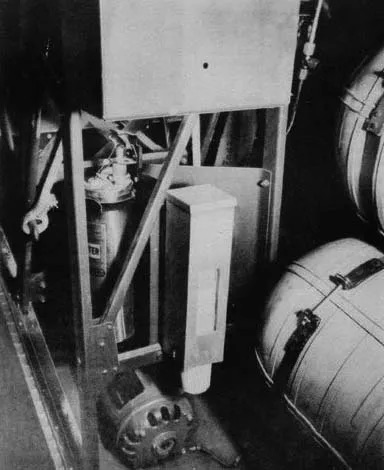
Manual illustration of the paper cup dispenser aboard a Boeing B-17F.
Note the Type A-2 carbon tet extinguisher adjacent. The layout on Lucky Thirteen is slightly different, the extinguisher being moved and the cup dispenser sitting next to the bomber’s crash axe.

The fully restored Toilet Paper Holder.
Wartime holders were produced by a Seattle Hardware as Part No. 2609, though Autoyre also produced them on the civilian market.
Photo taken 6 March 2019.
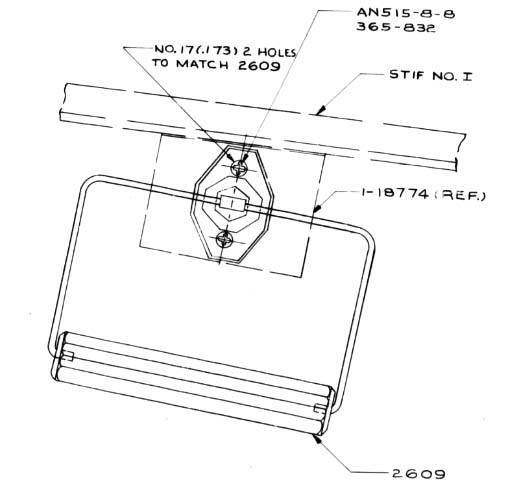
A close-up from Blueprint 55-7334 (Aircraft Lavatory) showing the Toilet Paper Holder.
The unit used on E-model B-17s was a different, bulkier design.
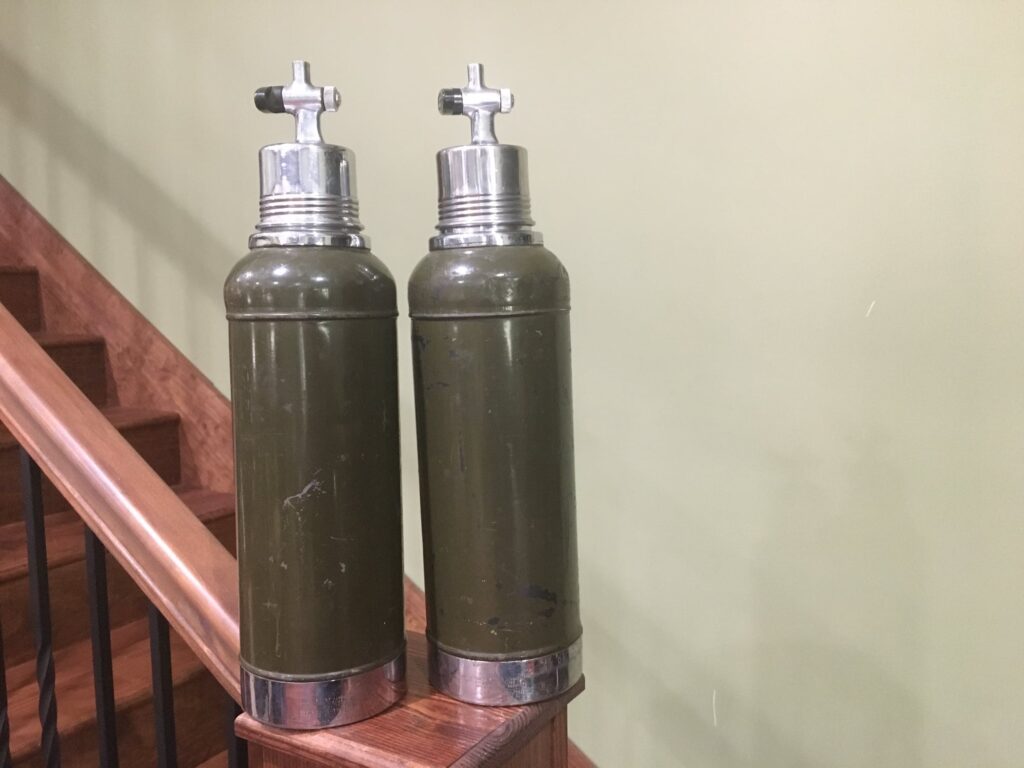
The thermos bottles for Lucky Thirteen.
The Army identification stamps are located on the rims at the bottom of each thermos.
Photo taken 13 May 2021.
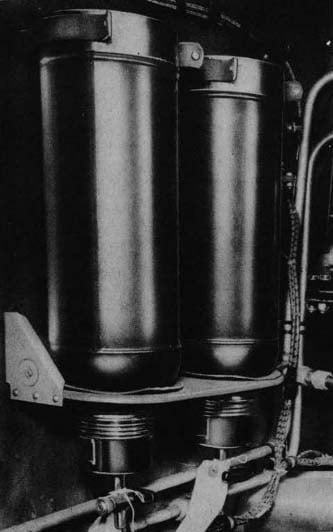
Manual illustration of the thermos bottles in their rack behind the co-pilot.
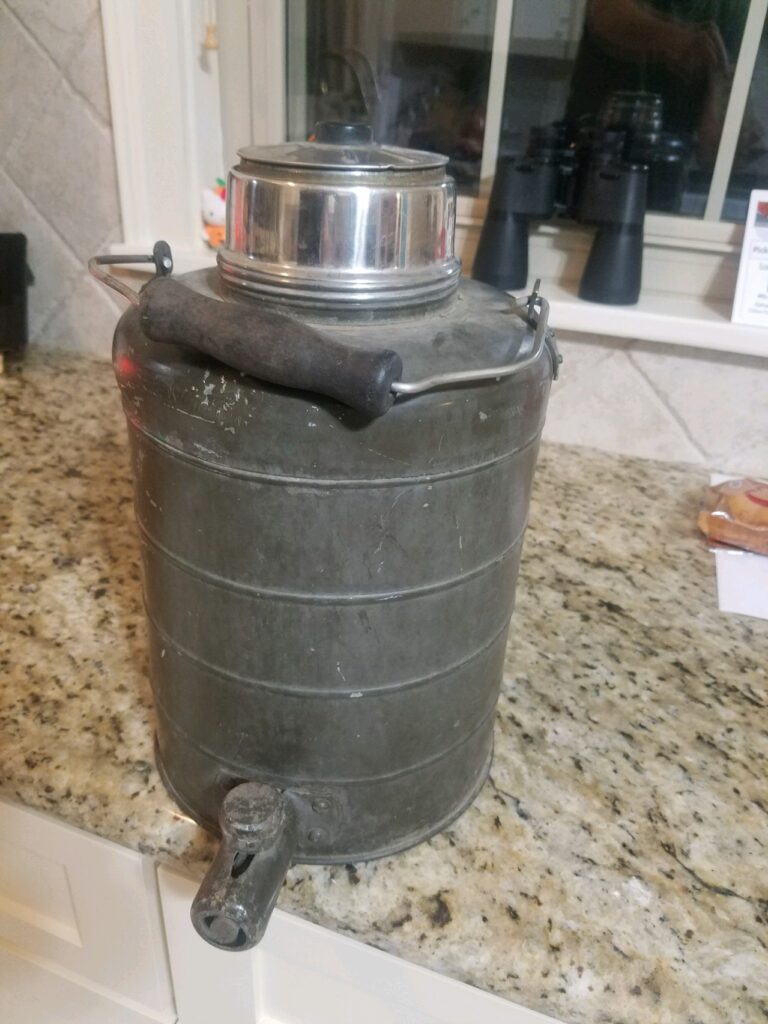
The recently acquired thermos for LB.30 Maid of Athens.
This style of thermos was common to many US-built aircraft. On the Boeing B-29, it was prominently mounted by the navigator’s desk.
Photo taken 23 October 2023.

Manual illustration of the LB.30’s flight deck. Frustratingly, the navigator’s chair has been removed for the photographer.
Note the thermos – an original unit has recently been purchased for the project. If anyone can help with its associated cup dispenser (seen here), please let us know!
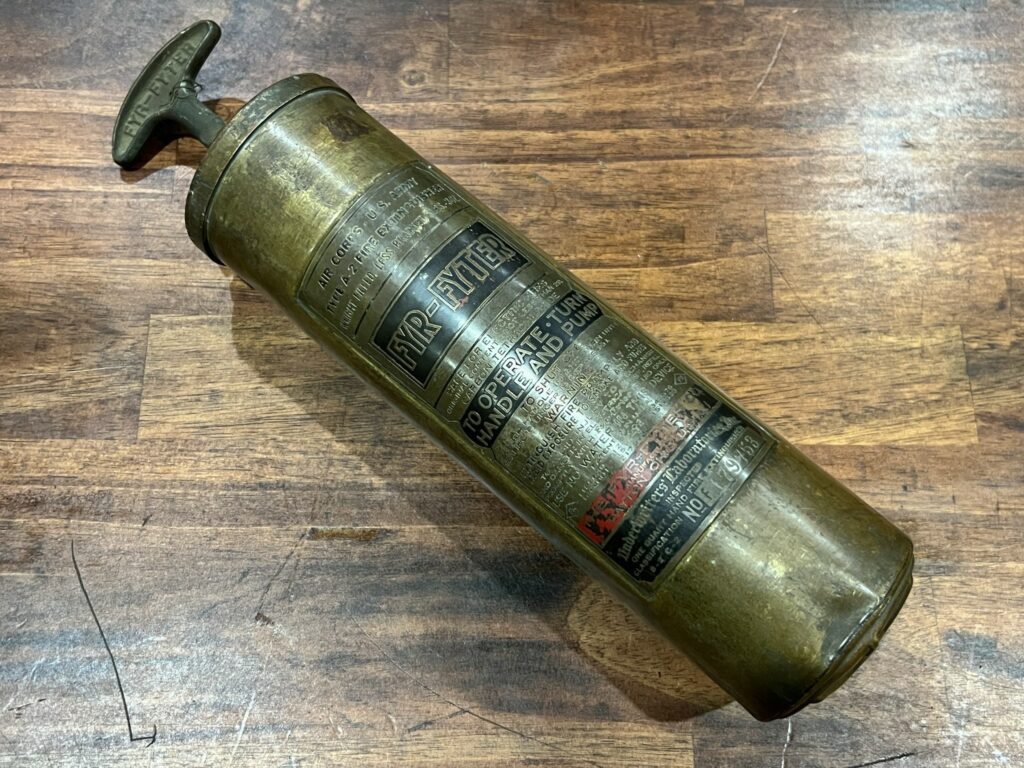
The newly-arrived Type A-2 carbon tet fire extinguisher.
It has not yet been restored.
Photo taken 1 December 2023.

A radio operator aboard a G-model B-17.
Note the Type A-2 carbon tet extinguisher mounted above his desk.
We were asked by the Liberty Foundation to cut some phenolic face plates for the overhead cockpit panel. The overhead panel housed the aircraft’s primary compass, clock, and de-icer pressure indicator. The request was to cut more panels than was needed, but at least one of these will be going to Liberty Belle.
I should note that the overhead panel did not have a phenolic face plate on E and F-model B-17s. For these aircraft, the panel was made of pressed aluminum. We actually have all the gauges which go in this panel – all of our metal-fabricating volunteers are just busy with other components. So, if anyone is interested in volunteering…
Speaking of the overhead panel, the clock for Lucky Thirteen was donated some time ago by Robert McHugh of Wantagh, New York. Robert just recently came through with another donation – thanks to Robert, we now have enough ashtrays to outfit Lucky Thirteen!
The Boeing B-17 carried ashtrays for the bombardier, navigator, pilots, and radio operator up until the G-series. They were procured ‘off-the-shelf’ from Ford, being the pull-out design from their 1936 line. These ashtrays can go for ridiculous prices and we are incredibly thankful for Robert in knocking out this need.
Lastly, we got a call from our friend Don Keller of B-17 Air Depot recently. A friend had presented him with a fuel transfer control for a B-17’s no. 3 and 4 engines. And it just so happened that Don had the corresponding control for the B-17’s no. 1 and 2 engines! Special thanks to Don for these incredible pieces!
The fuel transfer system was operated by the B-17’s flight engineer. The controls were mounted on Station 4, just underneath the cockpit door into the bomb bay. The B-17’s fuel tanks were primarily contained in the inner wings. The tanks for Engines 1 and 4 held 425 gallons each, Engines 2 and 3 held 213 gallons each, and a feeder tank behind each pair held an additional 212 each. Starting with late-Fs like Lucky Thirteen, additional fuel bladders in the outer wings (known as “Tokyo Tanks”) carried an additional 1,080 gallons. Excluding temporary bomb bay tanks used for ferry operations, the B-17 carried up to 2,780 gallons of fuel. With ferry tanks, this number increased to 3,600 gallons.

The newly-cut G-type overhead panel plates.
Phenolic was a common wartime material, better known today as Micarta. Similar to plastic, the phenolic was made from formaldehyde and resin-impregnated canvas.
Photo taken 20 November 2023.
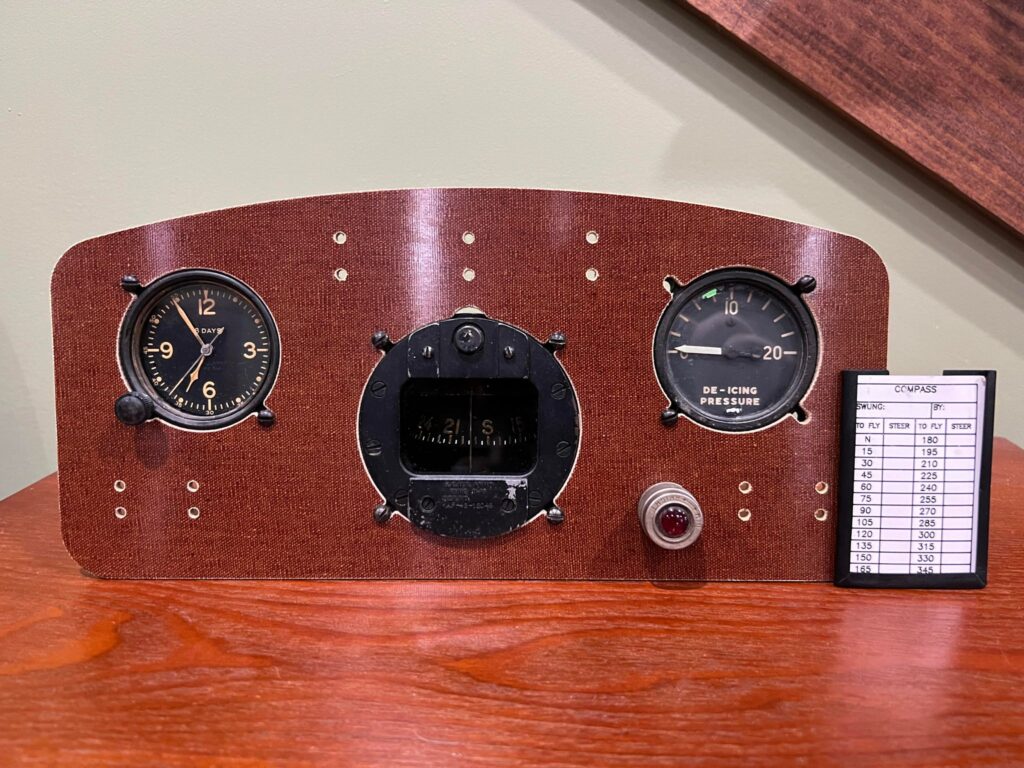
Just for fun, we fitted one of the Liberty Foundation’s overhead plates with the gear for Lucky Thirteen.
The compass correction card on the right is a wartime original.
Lucky Thirteen will need a panel made from pressed aluminum.
Photo taken 20 November 2023.

Manual photo of the Boeing B-17’s overhead panel.
Near the panel are controls for the SCR-269 Radio Direction Finder and SCR-274 Command Radio.
The plate under the overhead panel contains instructions for the bomber’s cowl flaps – one of the few hydraulic systems aboard the the B-17.

The Cowl Flap Instructions Plate and the Fuse Box Reference Chart for Lucky Thirteen.
A similar pair were sent to the National Museum of the US Air Force for installation on Memphis Belle that were appropriate for her serial number.
Photo taken 9 January 2020.
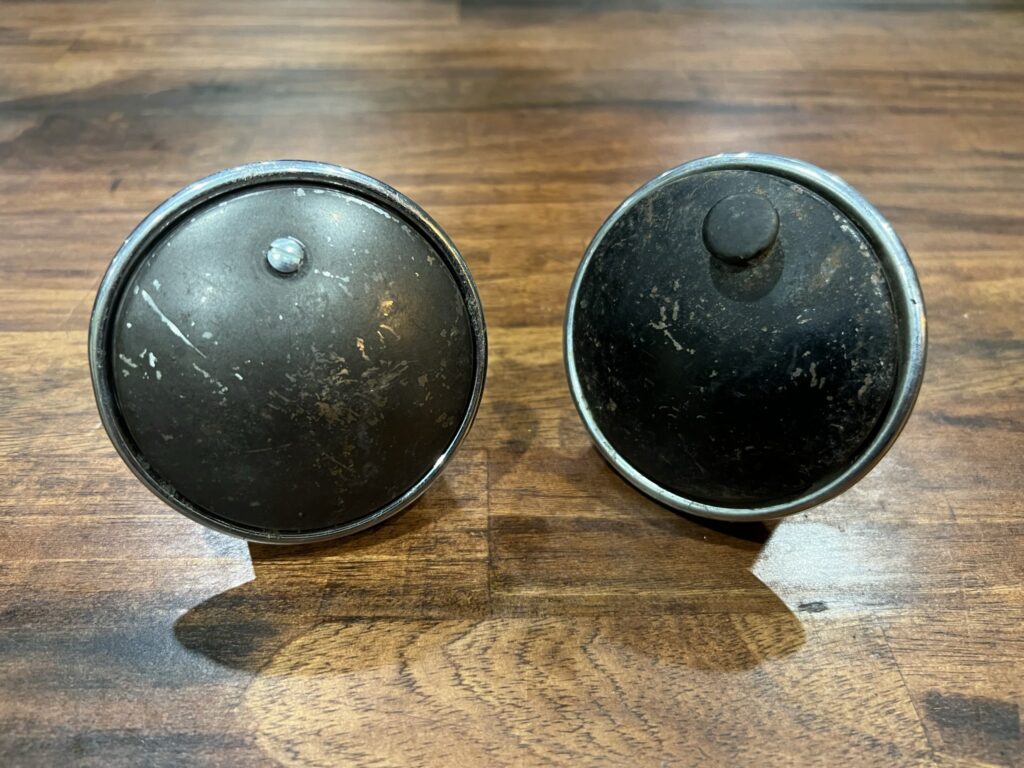
Robert’s newly donated 1936 Ford ashtrays.
Photo taken 26 November 2023.
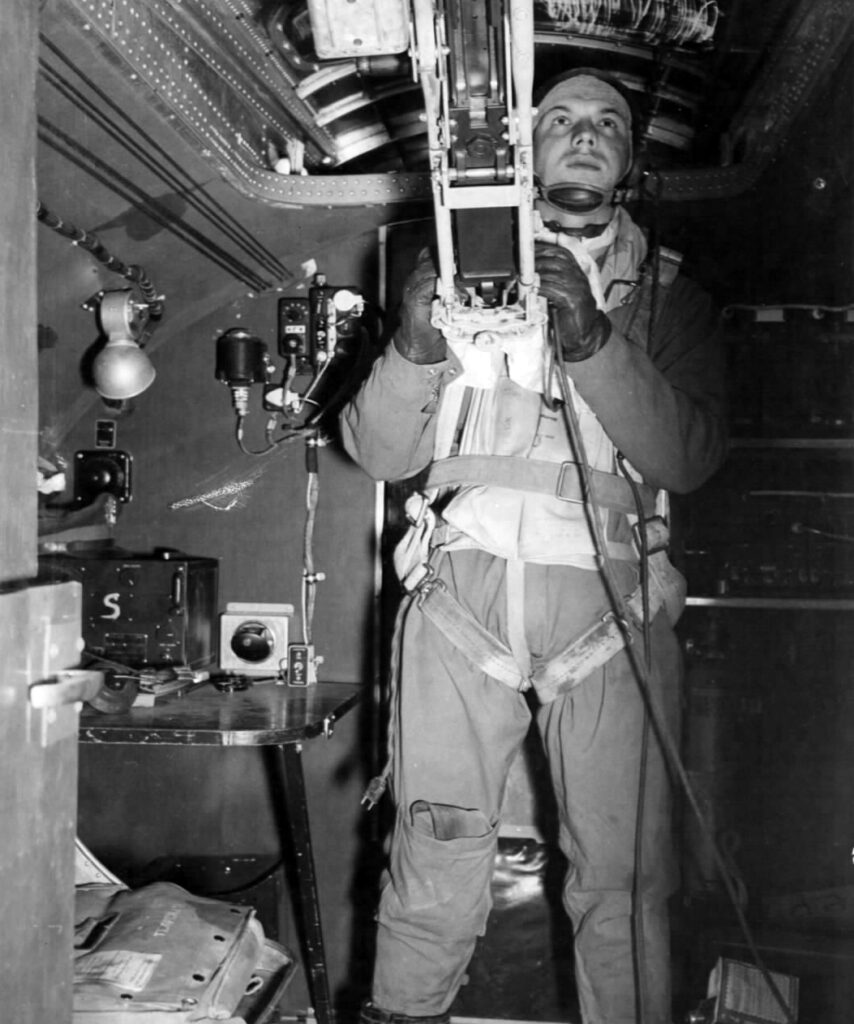
A radio operator aboard a B-17 based in Algiers with the 12AF.
This B-17 comes from somewhere partway through the F-series. While this aircraft still has the early style bucket seat, the linoleum table has been replaced with the later wood one (painted bronze green). The ashtray can be seen directly above the table, to the right of the BC-348 receiver.
Note how the Station 6 door has been cut in half. To deal with air pressure, the door was supposed to be open whenever the upper gun hatch was open. However, it was not uncommon for this door to be cut so that the lower half could be kept closed (keeping shell casings from falling into the ball turret gearing). This issue was ultimately solved in the G-series by adding a screen window to the door.

A radio operator at work aboard an early F-model B-17 (as indicated by the linoleum desk).
Note the nonstandard Morse-code key and clock. Likewise, the British issue explosive charges kept under the desk.
The knob from the ashtray is also missing, having been replaced by a wingnut.
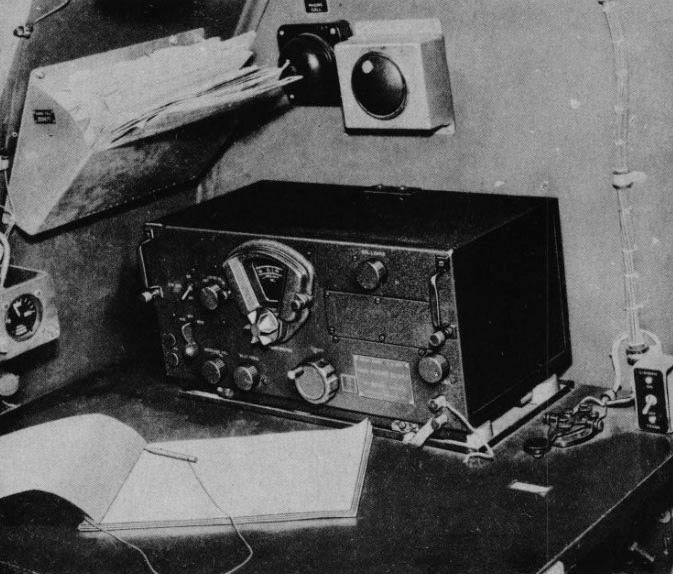
Manual illustration of a radio operator position aboard an F-model younger than Lucky Thirteen.
Note how the ashtray has been moved up beside the bailout bell, since the BC-348 now sits in the center of the table.
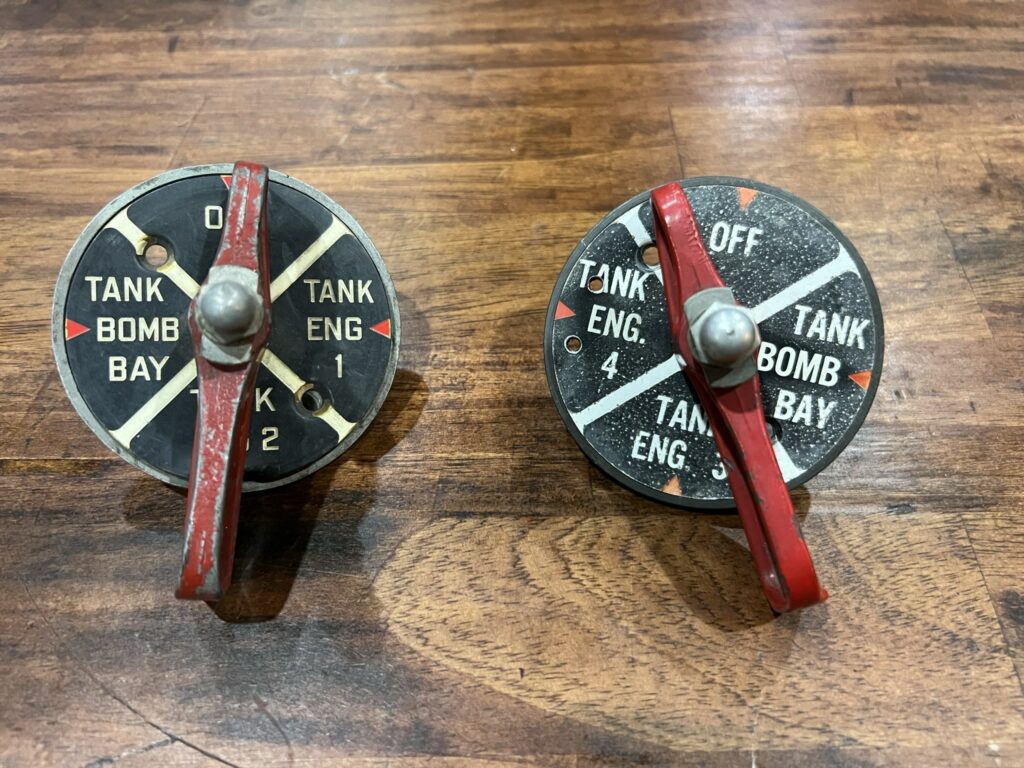
Don’s newly arrived fuel tank transfer controls.
Photo taken 26 November 2023.
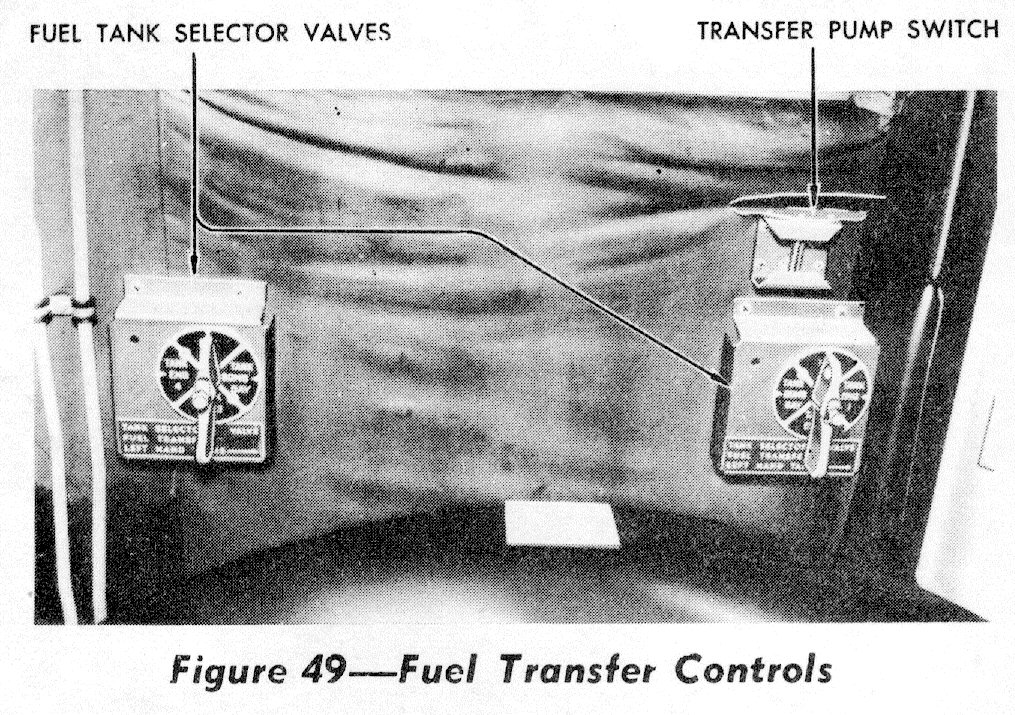
Manual illustration of the B-17’s fuel transfer controls.
These controls were located just underneath the cockpit door in Station 4. The area behind the controls is a green leather scuff pad. A similar scuff pad could be found under the door on Station 5.
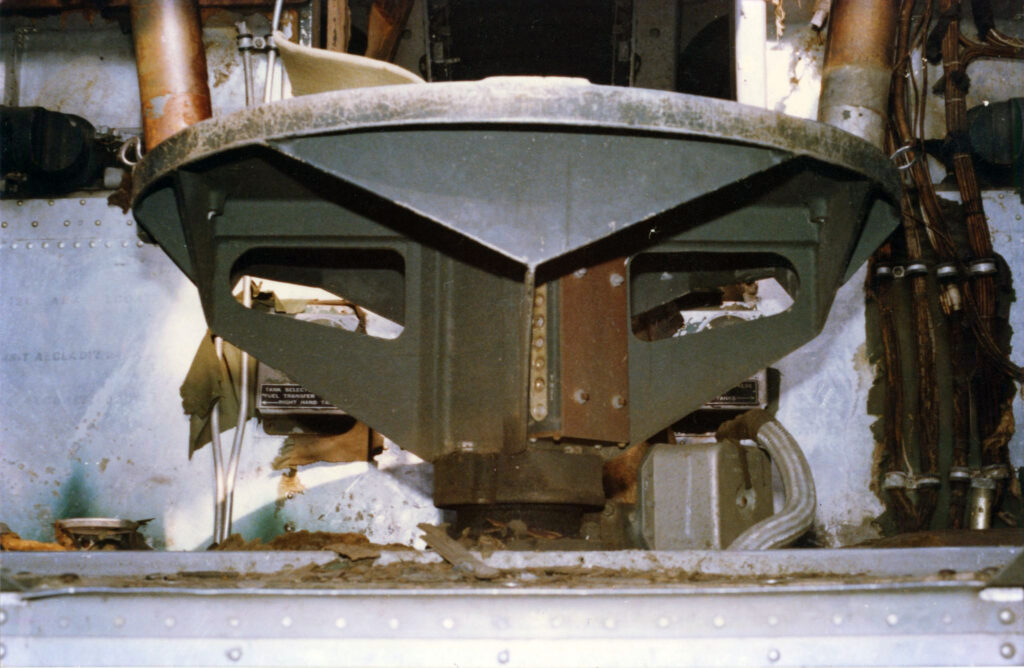
Photo taken aboard Memphis Belle (41-24485, 91BG) by volunteer Karl Hauffe in 1979.
This picture was taken in the nose crawlway, looking up into the cockpit, facing rear. The base of the Type A-1 Upper Turret partially blocks the view, but the fuel transfer controls can be partially seen here (along with remnant’s of the Belle‘s interior fabric).
I suppose everyone is getting used to my updates not being as regular as usual. Truth is, my family is expanding its woodshop – which should prove very useful in future projects for the B-17 and B-24. With the weather cooling, we are working at a faster pace than before, but it is taking up a lot more of my time.
We are still making progress though, so I hope everyone enjoys this week’s report:
First up is major step forward on the external lighting for Lucky Thirteen – a full complement of the bomber’s Type A-8 formation lights.
The Boeing B-17 carried a surprisingly large number of external lights. These included a pair of powerful landing units in the front of each wing, a red passing unit in the front of the left wing, six wingtip units (two on the stabilizer), two bomb release units (under the tail gun), three identification units (under the waist), and these seven formation units. The formation lights were scattered around the aft fuselage, with two on each horizontal stabilizer and three on the vertical stabilizer. The idea behind these blue lights was to identify the shape of the bomber’s tail in areas of poor visibility, hopefully minimizing the possibility of mid-air collision.
These lights are quite rare, as the lenses attach to their housings using rubber weather-seals. Over the years, this material could badly congeal, so scrapyards typically just removed the housings while scrapping the lenses. In fact, we had access to a cache of A-8 housings – just no lenses.
This set of NOS Type A-8s was purchased for just under 200 USD thanks to the generous donations of our supporters. Our deepest thanks to those who made this possible!
With the A-8s on hand, the only remaining exterior lights need for Lucky Thirteen are the aircraft’s two landing lights. While wartime landing lights are not terribly rare, the type used by the B-17 is somewhat harder to locate, as it did not hinge out like most. (The B-17’s wing was thick enough that it did not need to hinge downward.) For those who enjoy a good treasure hunt, these lights were designated AN3130-4560.
Another major step forward is our progress toward restoring the B-17F’s second CO2 extinguisher.
For those who may not remember:
The Boeing B-17’s standard extinguisher complement included three steel CO2 units and two brass carbon tetrachloride units. The carbon tet. extinguishers were Type A-2s manufactured by Fyr-Fyter of Dayton, Ohio. Originally, the standard CO2 unit was the Type A-17. At 18.75 inches long and 13 pounds, the A-17 is distinguishable by its unique valve assembly – to activate the unit, the horn was simply raised upward. Starting in 1943, the A-17 was slowly phased out in favor of the 4TB, which replaced the A-17’s brass valve with a simple handle-and-trigger.
Since Lucky Thirteen is an F-model B-17, it has been our goal to outfit her with Type A-17s. It has not been easy. Despite years of work, it was not until last July that we were able to locate all the necessary components to restore our first unit. It certainly felt great to have one completed!
Thanks to volunteer Chris Ely of Missouri, we are now fast on our way completing a second unit for Lucky Thirteen!
The only thing missing from Chris’s A-17 is the brass “cigar band” which served as both operating instructions and a clasp for the extinguisher’s horn. The artwork for this band has been recreated on the computer and is currently being engraved. Hopefully, this piece can be wrapped without much trouble.
We had managed to locate a third A-17 but a visit to an extinguisher shop saw them accidentally break the brass valve assembly in half. If the lower half can be removed from its cylinder, the valve assembly will have to be carefully welded back together. This is a longshot so we are hoping that another A-17 can be located to fill out the old bomber’s extinguisher complement. If anyone can help with this, please let us know!
Lastly, we wanted to share the bomber’s hydraulic hand pump.
Despite popular misconception, the B-17 carried few hydraulic systems, comprising only the brakes and cowl flaps. An electric pump was mounted beside the top turret near the Station 4 bulkhead, and a manual pump was located by the co-pilot for use in ground operations. This particular unit was located by our friend Eric Miller of Project Warbird, the handle and pump assemblies coming from two different expeditions.
Hydraulic handpumps are not altogether rare in the vintage aviation community, but great care was taken to find one for Lucky Thirteen that was the precise variant used on B-17s. (Postwar examples are quite common, for example, but can be easily differentiated by their markings.) The only discrepancy comes in the handle’s grip, which appears to be a large, rubber type in the manual illustrations. Something we will have to look into!
A special thanks once again to all of those who support our work, particularly those who locate and contribute parts, as well as those who support us financially. I will not embarrass them by publicly revealing their names, but three of our supporters have even gone so far as to set up a monthly donation plan – two via PayPal and one via check. Words can hardly express how much it means to us that you believe in our cause. Thank you so much.
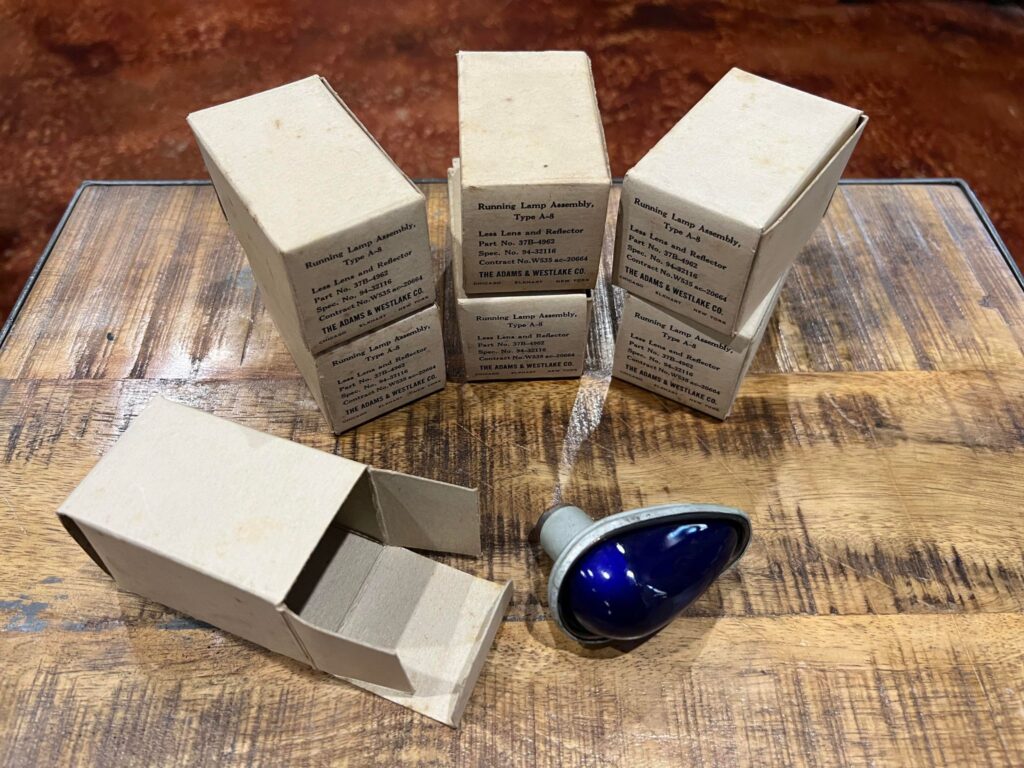
The newly-arrived Type A-8 formation lights for Lucky Thirteen.
Photo taken 16 November 2023.
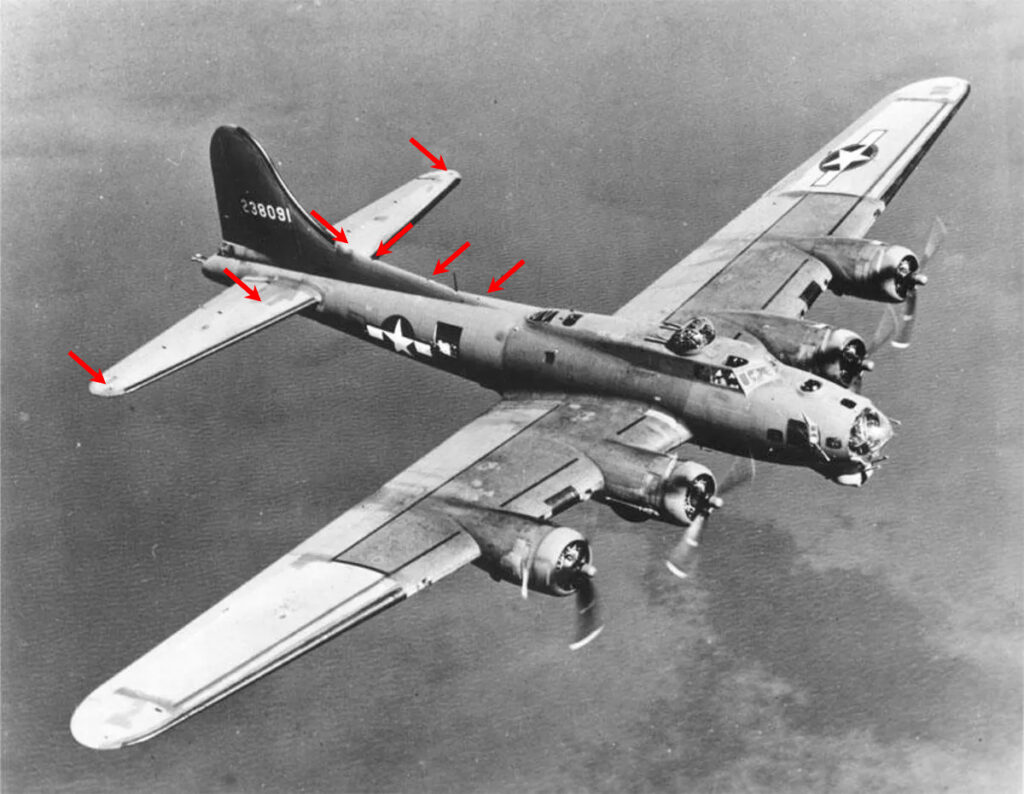
The location of the seven Type A-8 lights are highlighted in this Boeing B-17G photo.

The second Type A-17 for Lucky Thirteen, located by volunteer Chris Ely of Missouri, is restored and awaiting its brass band.
Photo taken 8 November 2023.
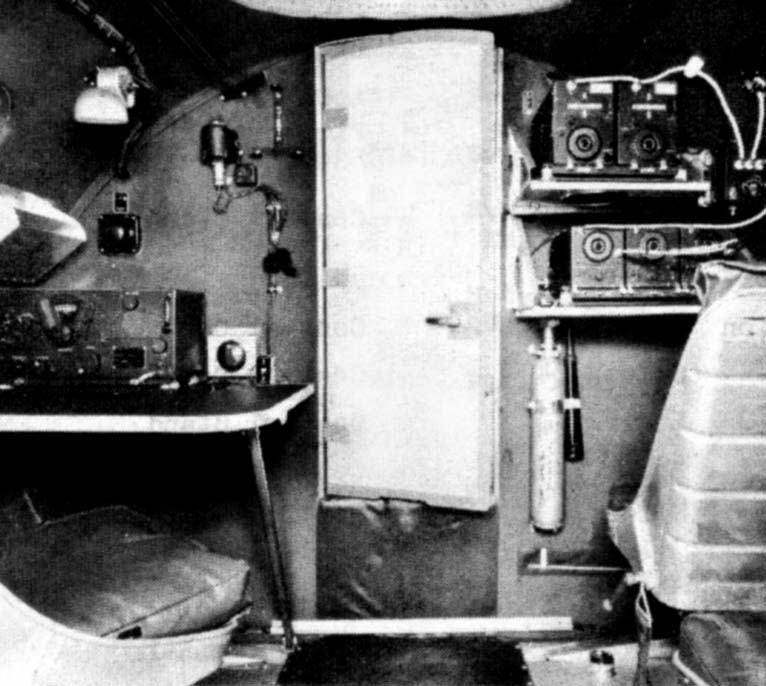
The radio compartment’s A-17 extinguisher is visible on the right in this photo from a B-17F slightly older than Lucky Thirteen.
At first aircraft CO2 extinguishers were unpainted, though this was later changed to light gray. Similarly, early units lacked the bulletproof mesh wrapping designed to minimize the danger of tank puncture.
While we have not found documentation to the effect, our research suggests that painting aircraft extinguishers red did not become common until after the war.

The first Type A-17 Fire Extinguisher restored for Lucky Thirteen.
The gray on this unit has been color-matched to an untouched portion of the extinguisher.
Photo taken 20 June 2023.
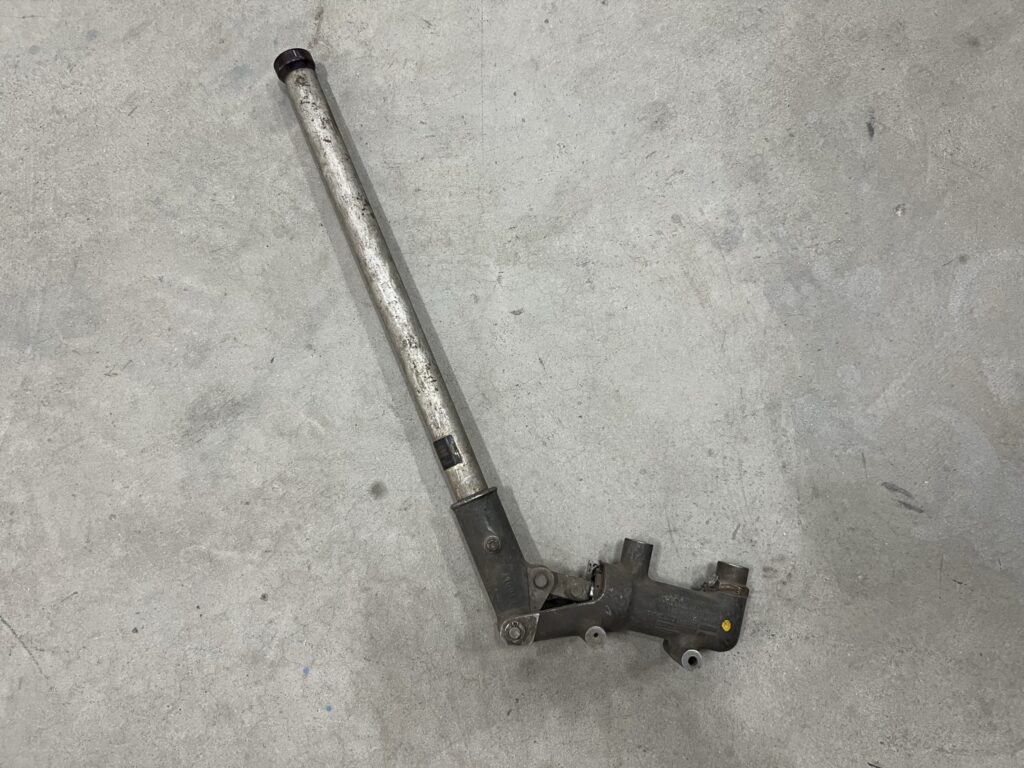
Eric Miller’s newly donated hydraulic handpump.
Photo taken 7 November 2023.
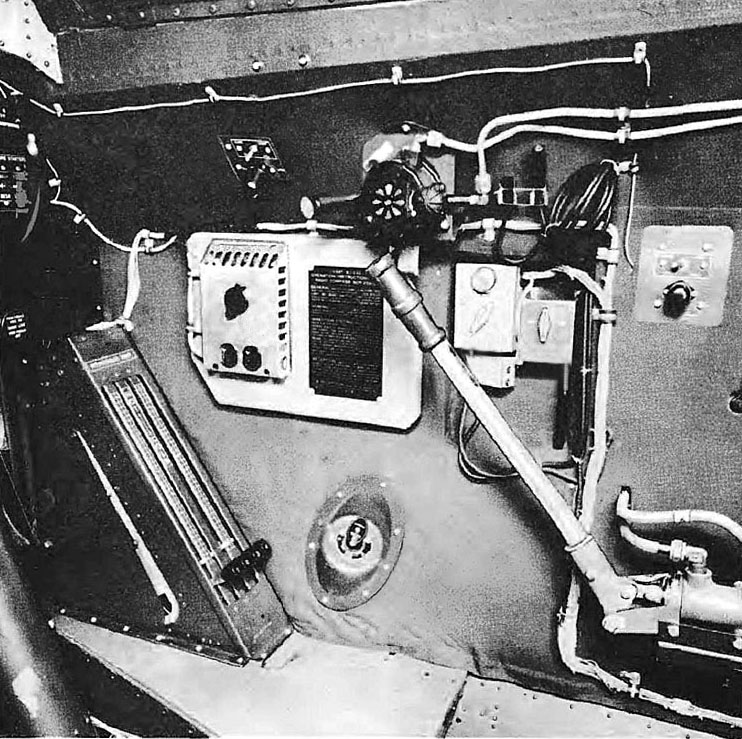
Manual illustration of the hydraulic hand pump to the right of the co-pilot’s position.
Not the large grip on the handle. If anyone can help us locate an example of this grip, please let us know!
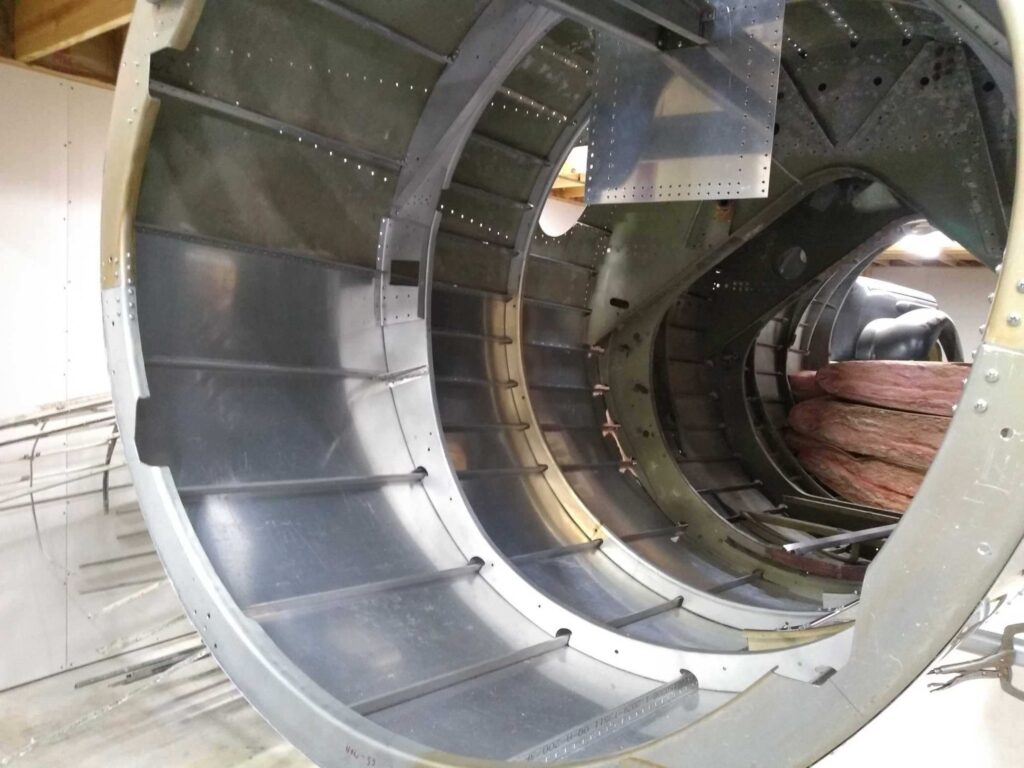
Progress on the aft fuselage of Lucky Thirteen.
Photo taken 14 November 2023.
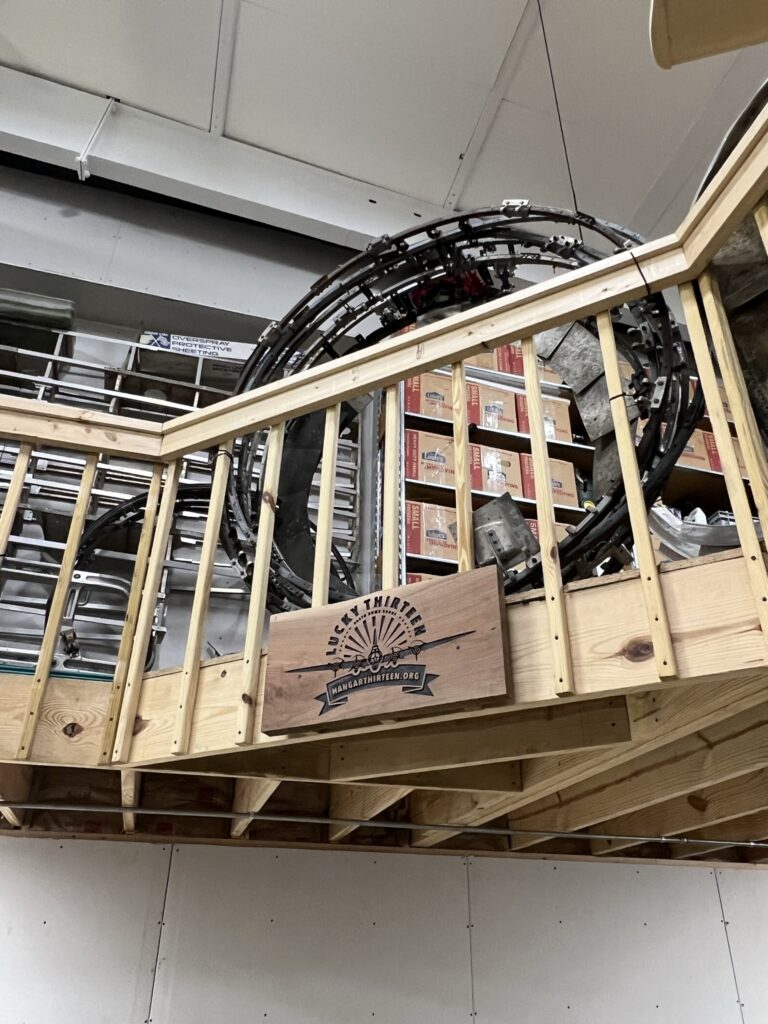
A wooden engraving of the Hangar Thirteen t-shirt design hangs above the side of the hangar, just underneath a set of cowl-flap rings for Lucky Thirteen.
Photo taken 7 November 2023.
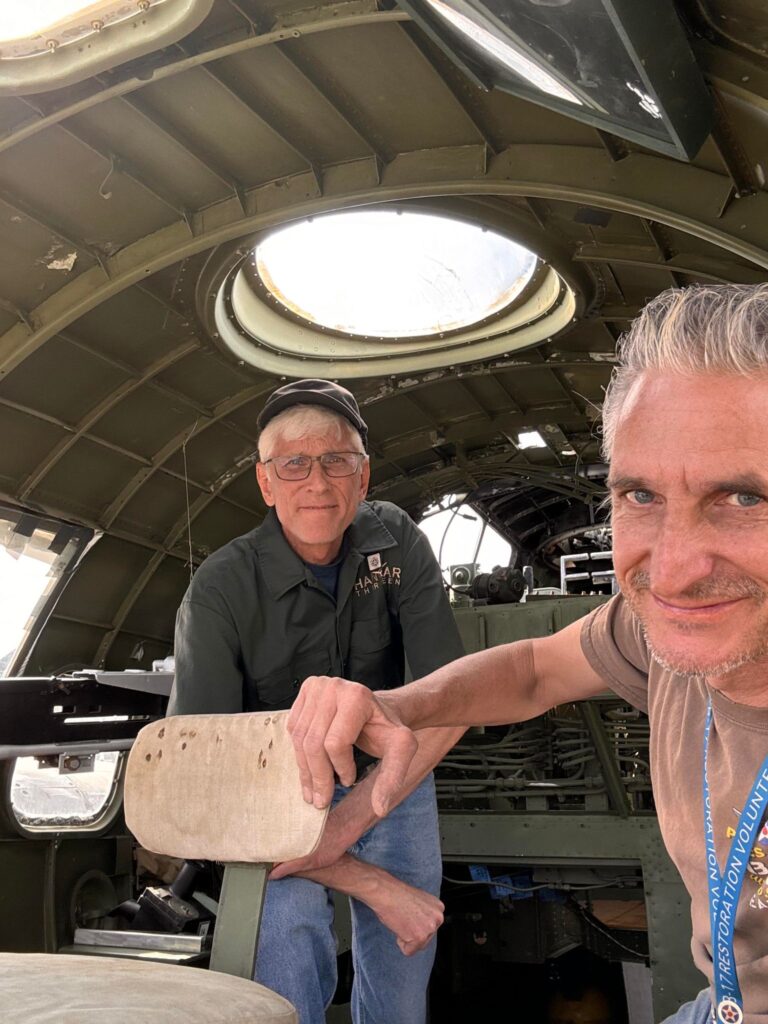
Two of the most awesome guys – Christopher Wilkinson and Steve Salinas – hanging out in the nose of Piccadilly Lilly II (44-83684) at the Planes of Fame Air Museum.
And Chris is sporting his Hangar Thirteen colors!
It was a lonely night and a single sentry stood guard, sheltering from the rain under the wing of a giant Boeing KC-97 Stratotanker. A flicker of light revealed a figure in the darkness, and the young sentry found himself confronted with menacing face of Curtis LeMay, commanding general of Strategic Air Command, cooly puffing on a cigar. “Sir, you can’t smoke here. This aircraft is filled with fuel – it might explode.” LeMay puffed, removed the cigar and growled. “It wouldn’t dare.”
This is a story familiar to almost all with an interest in aviation. It might be dismissed as apocryphal if it weren’t for all the veterans who personally experienced similar run-ins with the “Iron Eagle.”
But the sentry had a point – the Boeing KC-97 could hold up to some 13,600 gallons of fuel (88,400 lbs) in its fuselage, not including the 7,000 odd gallons in the wings. So, is it not amazing that barely a decade earlier, the United States provided ashtrays for its flight crews?
According to an annual Gallop poll started in 1944, over 41% of wartime Americans regularly smoked cigarettes (an average that would peak in 1954 at 45%). Boeing accounted for this in the B-17 by providing ashtrays in its closed compartments, with F-models like Lucky Thirteen carrying a maximum of five: ashtrays were mounted for the bombardier, navigator, two pilots, and radio operator.
The ashtray itself was purchased off-the-shelf from Ford, using a round pull-out model introduced by Ford in 1936. Surprisingly, despite their association with the Consolidated B-24, Ford did not use this same ashtray on the Liberator, instead using a dome-like model with a sliding top.
Like most Boeing B-17Fs, Lucky Thirteen carried four ashtrays, as the one in the navigator’s position was removed at the Cheyenne Modification Center, along with the original factory table. Boeing’s navigator table was a superb design featuring a slick wood top attached to an aluminum frame via a series of shock mounts. In the forward corner of the table was the master radio compass indicator, inlayed into the wood under a pop-up cover. The ashtray was mounted to the aluminum frame just underneath. With the introduction of cheek guns at the modification centers, these tables were regularly removed and replaced with simple wooden sheets.
Volunteer Chris Ely of Missouri sent over the first two ashtrays for Lucky Thirteen, which I thought everyone might enjoy seeing. We hope to install the radio operator’s tray to Station 5 soon though it will take some time as the mounting box for the tray is a bit more complex than it might at first appear.
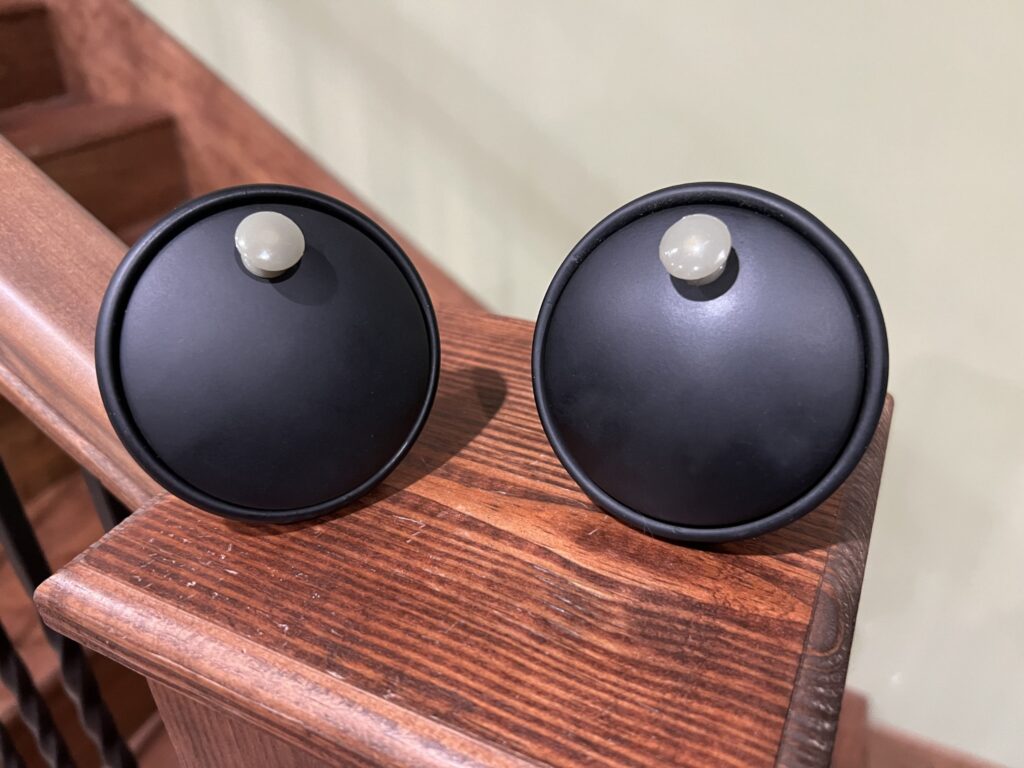
Chris Ely’s newly donated ashtrays.
Photo taken 30 October 2023.

The ashtray is visible center in the dash of this 1936 Ford Model 68.
The Ford Model 68 was a DeLuxe variant of the popular Model 48.

The ashtray is extended in the center of this 1937 Ford.
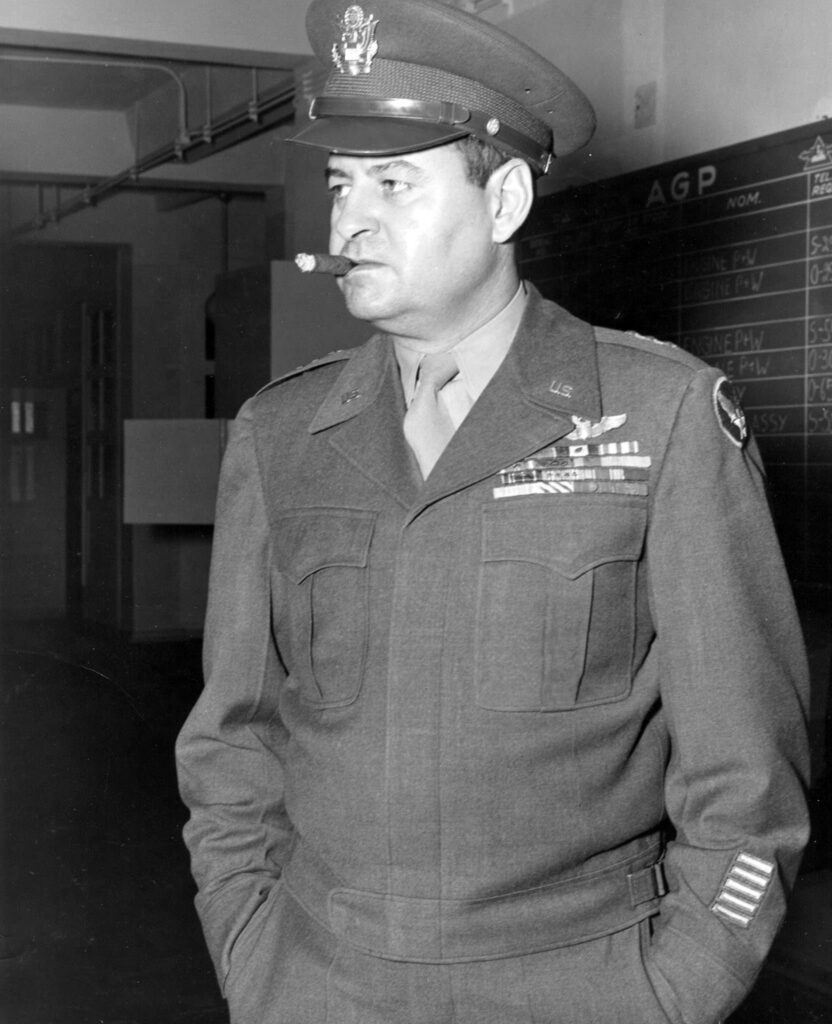
LTG Curtis E. LeMay during his tenure as CG United States Air Forces in Europe (the postwar equivalent of USSTAF.)
As CO 305BG at age 35, stress left LeMay’s face partially paralyzed with Bell’s palsy. Many believe his smoking habit was an attempt to hide this. In Europe he smoked pipes, but when transferred to the Pacific, switched to cigars after his pipes became moldy from the humidity.
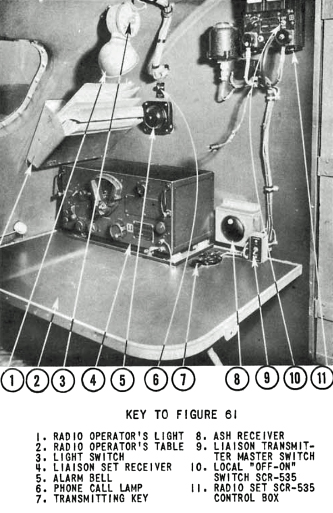
Manual illustration of the radio operator’s position aboard an F-model B-17. The ashtray is labelled as No. 8.
While this is an older F – as evidenced by the early IFF control box and linoleum table – the layout you see here is identical to that of Lucky Thirteen.
The radio operator’s ashtray was discontinued upon the introduction of the B-17G.
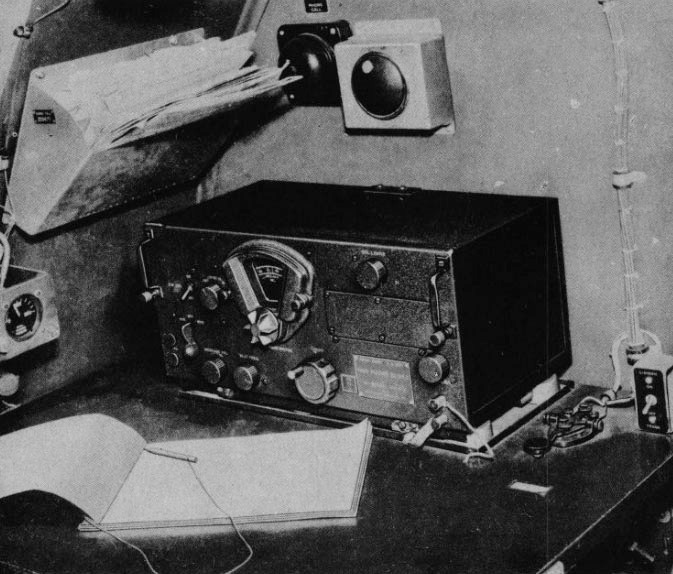
The radio operator’s position aboard a late B-17F.
Note how the ashtray has been moved up beside the bailout bell. This change was made after the BC-348 Receiver was shifted away from the wall closer to the center of the table.
Note the table: rather than a linoleum table, this one is wood painted bronze green. We have replicated this for Lucky Thirteen but have had trouble getting a decent photograph of it. It is very reflective!
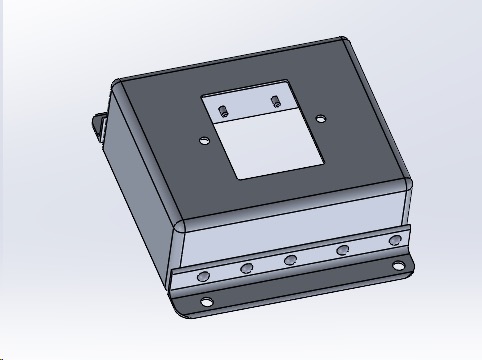
A 3D model of the radio operator’s ashtray made by volunteer Bob Hachmann.
Of all the volunteer possibilities at Hangar Thirteen, none have more options than those skilled with metal fabrication. If you have some experience therein, you are always welcome to participate!
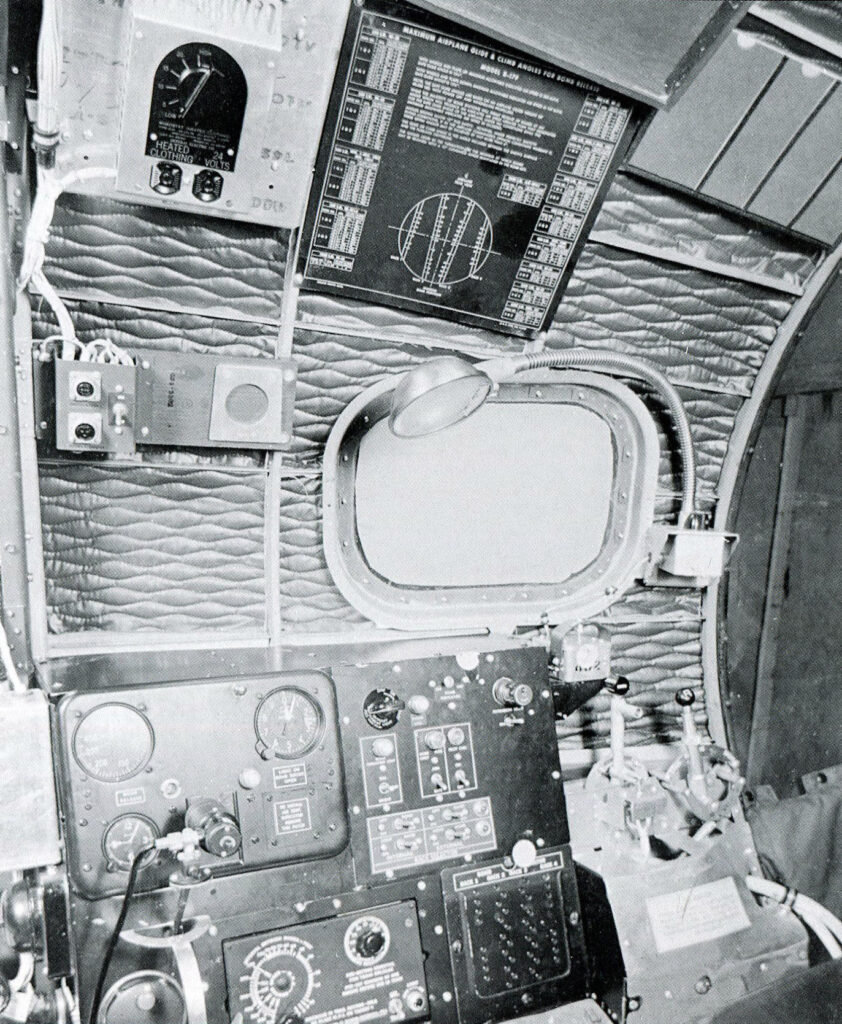
The bombardier’s position aboard Miss Carry (42-30323, 390BG), a late-F like Lucky Thirteen.
Note the piece at the top right corner: this is a 40D8435 Bombardier’s Instrument Calibration Card Holder. We have yet to see any surviving examples of these, so if you have one, please do let us know!
The bombardier’s ashtray is visible here on the bottom left of his instrument panel. The bombardier’s ashtray was discontinued in Block-115 of the F-series.
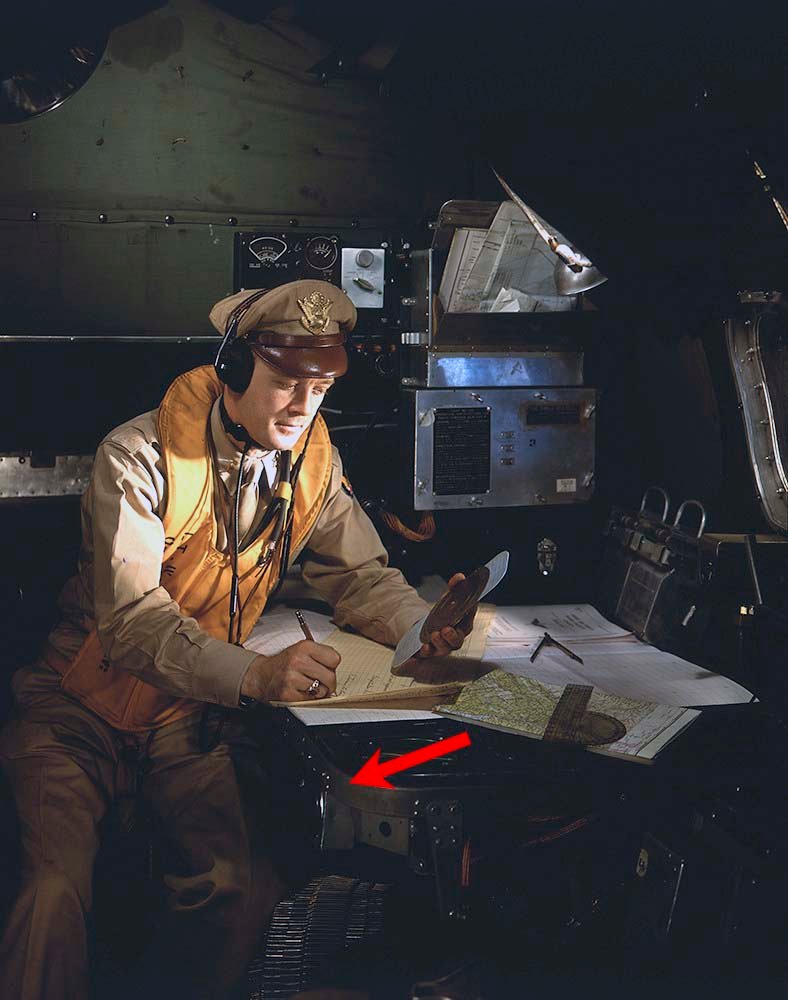
The navigator’s ashtray is highlighted in this color photo taken aboard a B-17E.
This table was regularly removed from aircraft which had cheek guns installed. With the G-series, the table (with its ashtray) were altogether replaced with a simpler, wooden design.

The navigator’s position aboard Flak Dodger (42-29467), an F with the 99BG.
The factory table has been replaced with a simpler one from the Cheyenne Modification Center. Note how the back to the seat has been attached upside down so the navigator could waddle on and off.
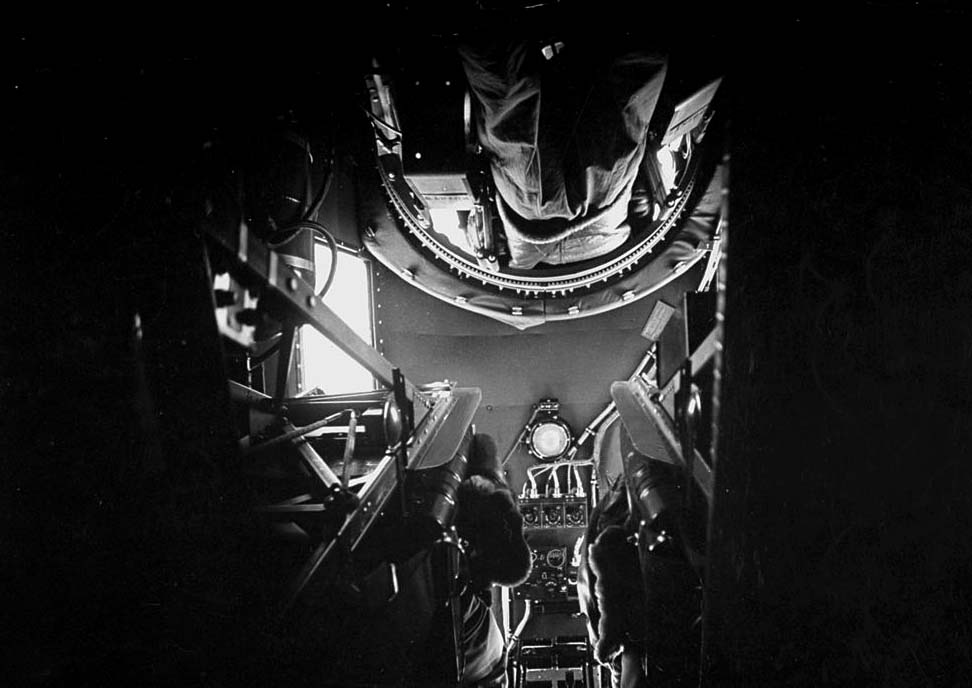
A rare angle, looking up from the nose crawlway into the cockpit of a B-17E. Ashtrays can be see under each of the pilot seats.
These ashtrays were removed upon introduction of the G-series.
The posture chairs aboard the Boeing B-17 were made by Cramer of St. Louis, Missouri, being a variant of their famous “Air Flow” series introduced in 1935. Originally, the posture chair was reserved for the navigator’s position, as the bombardier and radio operator used bucket seats up through the early F-models. However, by the Lucky Thirteen entered service, all three positions used posture chairs, with the bombardier’s position including a hinged back to allow the bombardier to waddle on and off his chair with greater ease.
Prominent in both B-17s and B-29s, posture chairs made for these aircraft can be easily distinguished from one another: B-17 chairs were upholstered in green vinyl, B-29 chairs in OD canvas; B-17 chairs had four legs and were strapped to the floor, B-29 chairs had three legs and slid on rails. As you might imagine, there are many B-17s today carrying B-29 posture chairs. This meant that replacing the seats for Lucky Thirteen would not be a simple task.
Followers might remember our friend Stijn Claus of the B-17 Flying Fortress Parts Project, who has generously recreated the green vinyl posture chair cushions for Lucky Thirteen. These were made using originals as patterns, along with a detailed walkthrough provided to us by Robert Wehner, who worked at Cramer making posture chairs during the war. Thanks Stijn!
Well, a few months ago our friend Dave Littleton of the B-17 Cockpit Project, introduced us to Shaun Riley. While not here on Facebook, Shaun has a number of B-17 component projects of his own and he offered to recreate the seat bases for Lucky Thirteen. Volunteer Bob Hachmann created new prints based on the Boeing installation prints and measurements taken from surviving examples, and Shaun went to work creating the posture chair bases for the navigator and bombardier positions. Thanks Shaun!
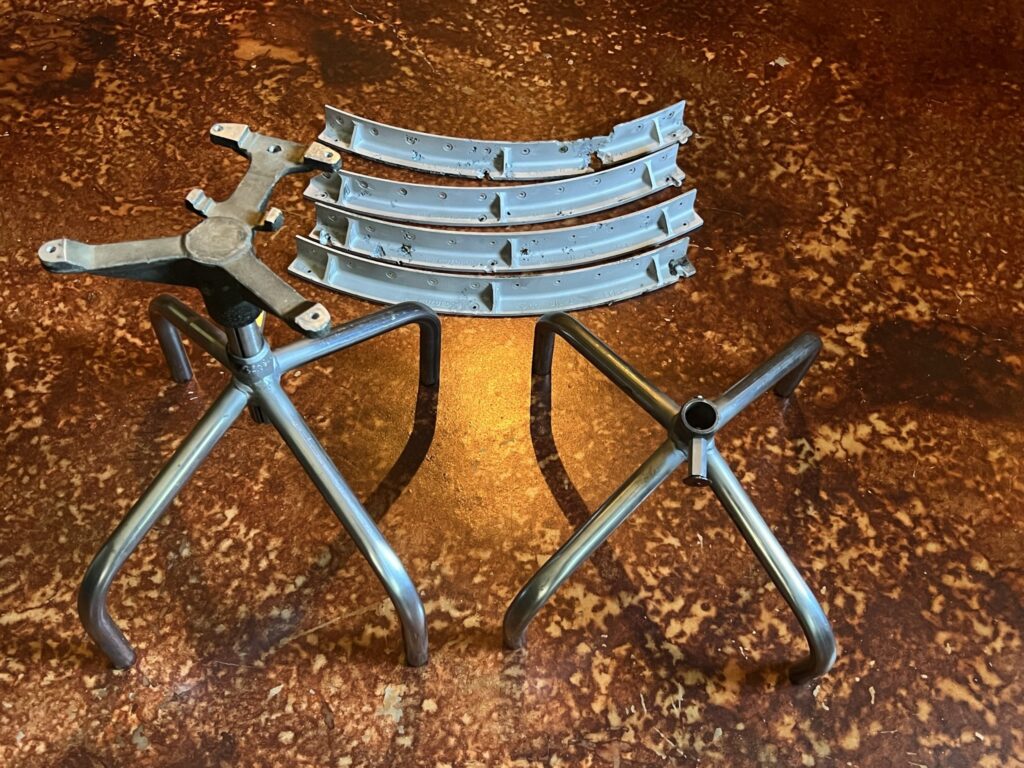
Shaun’s newly donated seat bases. The navigator’s seat base is the on the left (with the seat’s frame in place) and the bombardier’s on the right.
The pieces in the back are frames for the top turret’s ring assembly, given to us by Dave Littleton. We have been offered a ring for our top turret, but the asking price is 10,000 USD – so thanks Dave for taking pity on us!
Photo taken 19 September 2023.

Stijn’s newly donated seat cushions.
Photo taken 4 October 2023.
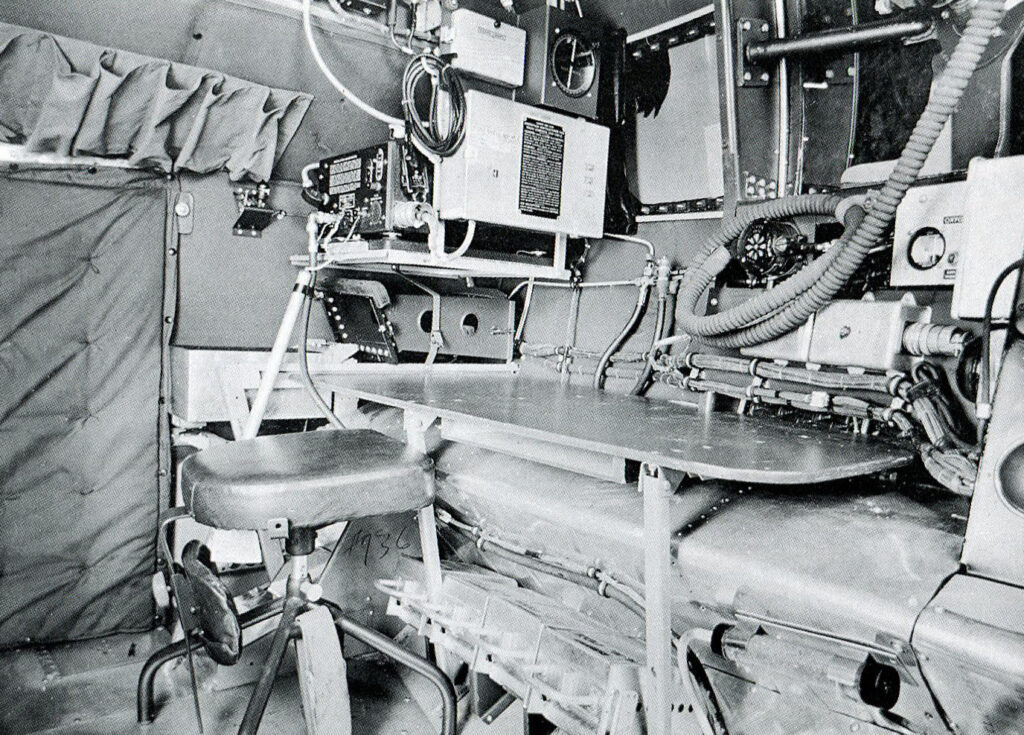
The navigator’s position aboard Flak Dodger (42-29467), an F with the 99BG.
The factory table has been replaced with a simpler one from the Cheyenne Modification Center. Note how the back to the seat has been attached upside down so the navigator could waddle on and off.

A navigator aboard a Boeing B-17G.
G-model B-17s replaced the strapped navigator’s chair with one mounted on a swivel. However, neither were popular and many navigator’s elected to sit on the floor (as shown here).
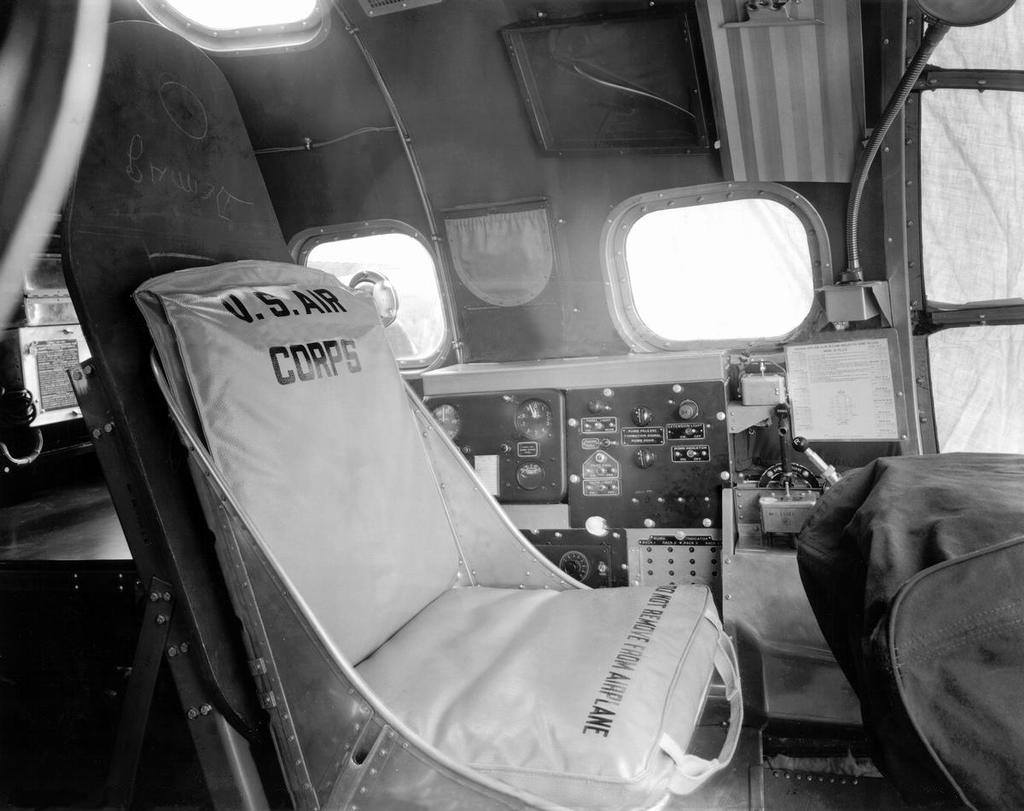
Up until partway through the F-series, the B-17’s bombardier position used a bucket seat.
This large and cumbersome assembly was not popular and many crews had this seat removed.

A B-17F where the bombardier’s seat has been altogether removed.
The nose gun setup you see here identical to the one found aboard Lucky Thirteen.

A bombardier aboard an F with the Cramer posture chair retained.
Note the hinge on the back rest arm – this was to make it easier for the bombardier to waddle on and off his chair.

Radio operator aboard an older F-model B-17 firing his hatch gun.
Note the bucket seat installed here. This seat was intended to mount an armor plate for added protection (removed here), but was eventually replaced with a Cramer posture chair.

A Cramer posture chair in the radar operator’s position aboard a B-17G Pathfinder.
Note the hinged back – this chair was taken from the bombardier’s position on an F-model.
